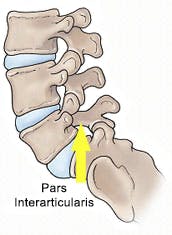

What is Spondylolysis?
Spondylolysis is a defect in a specific area of the bones in the back, or vertebrae, which make up the spinal column. It is most commonly seen as a stress fracture in the back that typically affects the low back region at the 5th lumbar vertebrae.
What causes Spondylolysis?
Spondylolysis results from a weakness in a section of the bones in the back called the pars interarticularis. This area connects the bones directly above and allows movement in the spine. The exact cause of the weakness is unknown. There may be a hereditary aspect in which people are born with thin vertebrae, making them more susceptible to fractures. In athletes, repetitive stress/trauma to the lower back can also weaken the pars interarticularis. Sports or activities that put a great deal of repetitive stress on the lower back, in addition to continuous hyperextension or overstretching of the spine, can result in a fracture on one or both sides of the vertebrae.
Signs and Symptoms
In many cases, spondylolysis may be present without any obvious symptoms. When symptoms do occur, patients will typically complain of low back pain that may feel similar to a muscle strain. However, with spondylolysis, the low back pain does not resolve in the normal healing time for a back sprain or strain. The pain is often described as a dull aching or cramping in the low back region and is generally worsened with vigorous exercise or activity. In addition, patients will typically have aggravating symptoms when bending backward (hyperextension) and with trunk rotation, and may have less pain when bending forwards. The typical age of a person diagnosed with spondylolysis is during adolescence (13-16 years old) and symptoms often appear during the teenage growth spurt.
Treatment Options
Initial treatment for spondylolysis is typically conservative. The treatment involves rest from sports and activities with high-stress loads placed on the low back, and physical therapy focused on stretches and strengthening of the back and abdominals. Your physical therapist will provide you with a thorough evaluation, followed by an individual program with specific exercises and stretches to perform on a regular basis. Occasionally, a back brace or corset may be indicated depending on the severity of the condition to help prevent extension of the lumbar spine. Your orthopedist will determine the best course of action.
Your physical therapist will give you specific guidelines for your child's individual needs.
